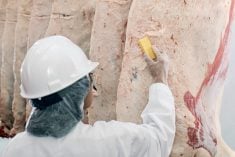Beef is still king of the meat case in U.S. grocery stores. But chicken wins hands down in per capita consumption and has done so for years. Beef is regarded as the meat treat and chicken the survival food for protein. Now that food inflation stalks grocery store aisles and talk is increasing about the U.S. economy slipping into recession, chicken will remain well ahead of beef as the affordable protein.
The three main sectors of the U.S. meat and poultry industry face different hurdles in the second half of 2022. But the main challenge common to all sectors is food inflation which is eating into Americans’ budgets and reducing consumer confidence in the economy. Inflation in May was 8.6 per cent above what it was a year earlier. While few economists believe the economy will slide into recession anytime soon, concerns about that occurring could alter consumers’ protein-buying patterns for the rest of the year.
An analysis of the most widely consumed protein, chicken, suggests the poultry sector is best positioned to deal with inflation at whatever level. In fact, as demand for chicken domestically and globally increases, the biggest issue might be one that other sectors would like to have — tight supplies. Despite cost pressures and operational challenges, the global poultry market is bullish, with high demand and tight supply, Rabobank noted in its third-quarter 2022 report.
Read Also

The Canadian Cattle Association’s international advocacy efforts
Global ag policies affect Canadian food policy, so the Canadian Cattle Association participates in international and domestic forums
As higher protein prices began to affect American consumers in the first half of the year, it was clear chicken would have a price advantage over the other main two proteins. The average retail price of chicken in May was US$2.42 per pound, according to USDA. This was up 18.6 per cent from May 2021 but was still half the price of pork and just over three times lower than the average All Fresh beef price.
Retailers by early June were publicly talking about how food inflation was causing more of their customers to buy more pork and chicken. This trend will continue through the rest of the year unless inflation significantly abates, say economists. The most pressure will be on beef, as it is by far the highest-priced protein.
The first signs of that pressure came in June as beef processors were forced to dramatically lower their asking prices on most middle meat items to attract forward sales. More consumers started to trade down in their beef purchases to ground beef, as they did in the 2009-2010 Great Recession, even though prices for its various forms were record-high in May and June.
Beef processors will continue to see pressure on middle meat prices. More Americans than in a long time indulged their taste for high-quality steaks while they were collecting federal stimulus money. But once those funds ended, many consumers began to revert to more frugal beef habits, especially as beef prices remained high. The May All Fresh price noted above was 9.5 per cent above May 2021, while the average price of Choice beef in May was up 10.3 per cent.
On the supply side, beef processors will face a shrinking supply of slaughter cattle by the middle of the fourth quarter. Beef cow slaughter through the first half of the year was up about 200,000 head or 9.5 per cent on the same period last year. Widespread drought forced the increase. Drought also kept forcing light cattle into feedlots. The June 1 cattle-on-feed total was record-large for the date. This means there are now fewer cattle outside feedlots to be placed, which means finished cattle supplies will start declining in October or November.
















